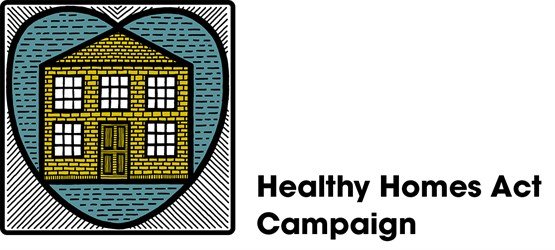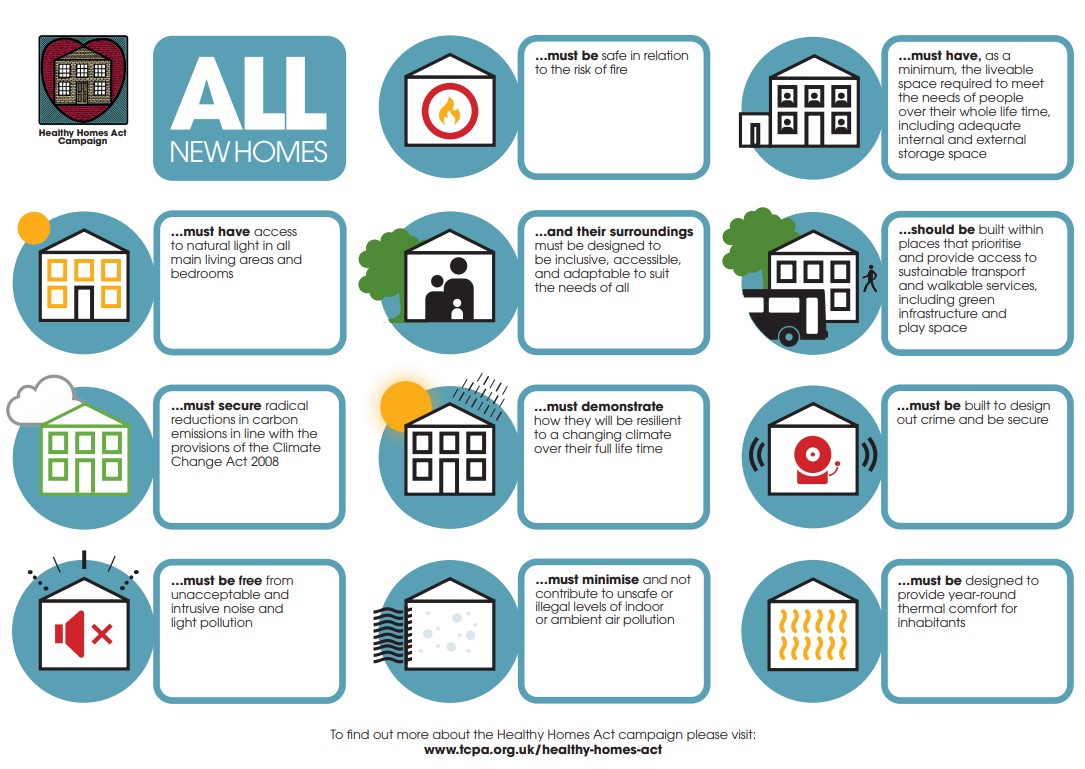Healthy Homes Act
Contents |
[edit] Introduction
The Town and Country Planning Association (TCPA) campaigns for reform of the UK’s planning system to make it more responsive to people’s needs and aspirations and to promote sustainable development.
In May 2019, TCPA introduced the Healthy Homes Bill - a campaign for legislation for the transformation of the quality of new homes in England.
[edit] Background
This measure came in response to research the TCPA undertook with University College London (UCL), which in one case study found that, using permitted development rights, a developer had increased the number of flats in a building by 33% above what was declared within their ‘prior approval’ application. This precedent was seen as potentially leading to overcrowding while preventing the local authority from planning to meet the needs of residents. In another example, researchers discovered a two-bed flat, again built using permitted development, having only one small window.
When the Bill was introduced, Fiona Howie, chief executive of the TCPA, explained that the very worst examples of unacceptable housing, “...have come through the deregulated conversion of old office blocks and storage facilities into housing units. The creation of these cramped and substandard housing units is even more scandalous, given what we know about the impact of housing conditions on people’s health and wellbeing. Poor quality, badly designed housing damages people’s life chances.”
The announcement of the proposed Act coincided with the centenary of the Housing and Town Planning Act 1919, a key piece of legislation that helped transform the quality and delivery of council housing, giving ordinary people a decent home.
Howie said, “We have gone backwards over the last 100 years. The Healthy Homes Act will help make sure that new homes built today leave a positive legacy.”
[edit] 10 healthy principles
The purpose of the proposal is to make ministers aware of proactive measures that should be taken for all new housing to meet 10 basic quality, safety and placemaking principles that collectively constitute the minimum standard for ‘decent’ homes.
According to the 10 principles, all new homes must:
- Be safe in relation to the risk of fire.
- Have adequate liveable space.
- Have access to natural light for all main living areas and bedrooms.
- Be accessible and have environments with access to natural light.
- Be within walkable neighbourhoods (if within major developments).
- Secure radical reductions in carbon emissions in line with the provisions of the Climate Change Act (2008).
- Have walkable access to green and play space which is open to everyone.
- Be resilient to a changing climate.
- Be secure and meet designing out crime standards.
- Meet enhanced standards to prevent unacceptable noise pollution.
[edit] Supporting the campaign
At the core of the proposal is an ongoing research project funded by the Nationwide Foundation and supported by several businesses, charities and other organisations.
Ref https://www.tcpa.org.uk/healthy-homes-act
[edit] Related articles on Designing Buildings Wiki
- Affordable housing.
- Building for life.
- Housing standards review.
- Lyons Housing Review.
- Raynsford Review.
- The full cost of poor housing.
- The future of housing.
- Town and Country Planning Association TCPA.
[edit] External resources
- TCPA, Healthy Homes Act.
Featured articles and news
RTPI leader to become new CIOB Chief Executive Officer
Dr Victoria Hills MRTPI, FICE to take over after Caroline Gumble’s departure.
Social and affordable housing, a long term plan for delivery
The “Delivering a Decade of Renewal for Social and Affordable Housing” strategy sets out future path.
A change to adoptive architecture
Effects of global weather warming on architectural detailing, material choice and human interaction.
The proposed publicly owned and backed subsidiary of Homes England, to facilitate new homes.
How big is the problem and what can we do to mitigate the effects?
Overheating guidance and tools for building designers
A number of cool guides to help with the heat.
The UK's Modern Industrial Strategy: A 10 year plan
Previous consultation criticism, current key elements and general support with some persisting reservations.
Building Safety Regulator reforms
New roles, new staff and a new fast track service pave the way for a single construction regulator.
Architectural Technologist CPDs and Communications
CIAT CPD… and how you can do it!
Cooling centres and cool spaces
Managing extreme heat in cities by directing the public to places for heat stress relief and water sources.
Winter gardens: A brief history and warm variations
Extending the season with glass in different forms and terms.
Restoring Great Yarmouth's Winter Gardens
Transforming one of the least sustainable constructions imaginable.
Construction Skills Mission Board launch sector drive
Newly formed government and industry collaboration set strategy for recruiting an additional 100,000 construction workers a year.
New Architects Code comes into effect in September 2025
ARB Architects Code of Conduct and Practice available with ongoing consultation regarding guidance.
Welsh Skills Body (Medr) launches ambitious plan
The new skills body brings together funding and regulation of tertiary education and research for the devolved nation.
Paul Gandy FCIOB announced as next CIOB President
Former Tilbury Douglas CEO takes helm.
UK Infrastructure: A 10 Year Strategy. In brief with reactions
With the National Infrastructure and Service Transformation Authority (NISTA).
























